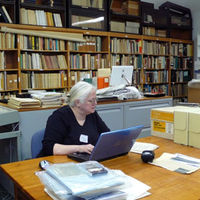Papers by Grace Erny
Archaeological Ethics in Practice (AASOR 78), 2025
Sexism and gender-based harassment pervade archaeological research in the Mediterranean and the N... more Sexism and gender-based harassment pervade archaeological research in the Mediterranean and the Near East. These issues affect the demographics of the field and shape archaeological knowledge production. Although recent efforts to develop codes of conduct for archeological projects and professional conferences are important, any plan to end gender harassment in archaeology must confront structural issues of sexism and power in academic settings in order to be truly effective. Furthermore, the burden of addressing sexism cannot fall primarily upon its victims. This paper outlines the scope of the problem and proposes concrete steps towards building a more ethical future for archaeology and the academy.
Bulletin archéologique des Écoles françaises à l’étranger, 2022
Date précise de l'opération : 19 juillet-27 août Autorité nationale présente : Heidi Senn, survei... more Date précise de l'opération : 19 juillet-27 août Autorité nationale présente : Heidi Senn, surveillante désignée par l'Éphorie des Antiquités du Lasithi Numéro de mission : I33 Composition de l'équipe de terrain : Pierre Baulain (Éducation nationale ; Zone 4.0 : Quartier de la forge/Bâtiment A ; semaines 1-3), Romain Machavoine (Galerie Kugel ; Zone 4.1 : Quartier de la forge/Bâtiments B et C ; semaines 1-3), Grace Erny (Stanford University/ASCSA ; Zone 4.4 : Terrasse Demargne ; semaines 1-4) et Anastasia Paillard (U. Lille, CNRS, Minist. Culture, UMR 8164 HALMA, Lille ; Zone 1 : nécropole ; semaines 4-6) ont encadré le travail des équipes et veillé à la documentation systématique des opérations, sous la supervision scientifique
The 2019 Bays of East Attica Regional Survey (BEARS) Project: New Archaeological Evidence for the History of Coastal Settlement, Economy, and Connectivity from Porto Rafti (Greece)
This paper presents the findings of the inaugural season of the Bays of East Attica Regional Surv... more This paper presents the findings of the inaugural season of the Bays of East Attica Regional Survey project (BEARS). The project aims to clarify the history of human activity around the bay of Port...
Bulletin archéologique des Ecoles françaises à l'étranger 4, 2023
abords ; semaines 1-2) ont encadré le travail des équipes et veillé à la documentation systématiq... more abords ; semaines 1-2) ont encadré le travail des équipes et veillé à la documentation systématique des opérations, sous la supervision scientifique de Florence Gaignerot-Driessen. Alexia Lattard a guidé la fouille des espaces de crémation dans la Zone 1 et conduit une étude préliminaire du mobilier osseux. Kyriaki Tsirtsi (Cyprus Institute, STARC) a supervisé la flottation des échantillons de terre prélevés sur le site en 2018, 2019 et 2021.
Hesperia, 2024
The Western Argolid Regional Project (WARP) is an intensive pedestrian survey of 30 km2, located ... more The Western Argolid Regional Project (WARP) is an intensive pedestrian survey of 30 km2, located northwest of Argos along the banks of the Inachos River. Using high-intensity collection strategies, WARP generated very fine-resolution data that provide insights into the ways this seemingly marginal area contributed to and was impacted by regional histories. A key question is how the network of mountainous routes that traverse this landscape, connecting the area to the Corinthia and Arkadia, may have influenced localized, diachronic settlement patterns. This article focuses on areas of high artifact densities to demonstrate how regional activity and interconnectivity changed from the Neolithic to Modern period at this crossroads in the northeastern Peloponnese.

Annual of the British School at Athens, 2024
This study addresses a longstanding historical and archaeological problem at the central Cretan u... more This study addresses a longstanding historical and archaeological problem at the central Cretan urban centre of Knossos. This is the so-called 'Archaic gap', an apparent dearth of evidence for sixth-century BCE material culture across the extensively excavated city. The concept of a pronounced Knossian decline or recession at this time has been reaffirmed in recent years, with widespread repercussions for Cretan archaeology. By reconsidering ceramics from the Royal Road North and Unexplored Mansion excavations, as well as situating these deposits within their urban and regional contexts, I question the epistemological foundations of the Knossian gap and provide new directions for identifying sixth-century Knossian material culture. I propose that the apparent 'gap' is a product of several factors: (1) a relative disinterest in imports in sixth-century Knossos, (2) a dispersed, rather than densely nucleated, urban settlement pattern, and (3) a previously unrecognised conservatism in Knossian ceramics, where some of the 'Orientalising' styles traditionally dated to the seventh century were retained into the sixth. This phenomenon of conservatism differs in important ways from the 'restraint' or 'austerity' that has been previously proposed as characteristic of Archaic and Classical Crete.

Journal of Mediterranean Archaeology, 2023
Over the past fifty years, intensive Mediterranean archaeological surveys have yielded abundant a... more Over the past fifty years, intensive Mediterranean archaeological surveys have yielded abundant and diachronic archaeological data. Although field methods have been continually debated and refined, the interpretation of survey results has focused primarily on site numbers and site size, with particular interest in reconstructing settlement hierarchies and in tracking episodes of nucleation and dispersal across the landscape. Artifact assemblages are largely used to date sites, while less attention has been devoted to assemblage diversity and site function. This study demonstrates the potential of legacy survey data to frame and answer new research questions via an analysis of 250 small rural sites of the first millennium BC recovered by intensive surveys on Crete from the 1970s through the early 2000s. I show that diachronic patterns of rural settlement in Crete depart strongly from those observed in mainland Greece and also differ between Cretan regions. I also reveal pronounced variation in the assemblages present at small sites across the island within regions and periods. This suggests that we cannot simply interpret all small sites as homogeneous farmsteads. Finally, I discuss the challenges and potential of using diversity measures as an exploratory tool for analyzing legacy survey data. Methods outlined here could be productively applied in other Mediterranean regions.

American Journal of Archaeology, 2023
This article presents the results of a demographic survey of authors who published in the America... more This article presents the results of a demographic survey of authors who published in the American Journal of Archaeology between 2000 and 2020. We sought to better understand the demographics of knowledge production in one of the major English-language journals for Mediterranean archaeology, and, by extension, in the field in general. The survey, delivered by email in the spring of 2021, asked authors about their gender, race or ethnicity, nationality, sexual orientation, the educational attainment of up to two of their parents, their current academic position and rank, and the number of times they have published in the AJA. Our results indicate that people of color and the children of parents without advanced degrees are greatly underrepresented among AJA authors over the past two decades when compared to the U.S. population as a whole-a phenomenon that likely confirms many scholars' perceptions of the field but has not yet been empirically demonstrated. We conclude with some reflections on possible causes of underrepresentation and suggestions for creating a more inclusive discipline and publication process.

Journal of Eastern Mediterranean Archaeology and Heritage Studies, 2022
This Forum turns a critical eye on the social networks of eastern Mediterranean archaeology. We f... more This Forum turns a critical eye on the social networks of eastern Mediterranean archaeology. We focus on gender sociology and knowledge production within the subfield of Aegean survey, particularly on survey projects conducted in Greece and Cyprus. Through analysis of both survey directorship and survey publication teams, we clarify several major questions. Whom do scholarly networks of survey directors omit? And what do we miss when we view the development of survey (1) from a top-down perspective, as the creation and legacy of project directors, and (2) with a focus on field methods and artifact collection rather than the interpretation of survey data? Five archaeologists with field experience in the eastern Mediterranean then discuss these questions as they relate to their own experience and area of specialization.
Phoenix, 2022
This paper uses the dialogue between the Cretan heroes Idomeneus and Meriones in Iliad 13 as a st... more This paper uses the dialogue between the Cretan heroes Idomeneus and Meriones in Iliad 13 as a starting point for understanding Homeric conceptions of Crete. Depictions of Crete in Homeric poetry both responded to historical realia and produced an enduring image of Crete as a geographically marginalized yet mythopoetically important place.
Journal of Field Archaeology, 2020
Fieldwork at the settlement of Chelmis in the Western Argolid provides a case study in the archae... more Fieldwork at the settlement of Chelmis in the Western Argolid provides a case study in the archaeological documentation of the Modern landscape of Greece. Over the last 40 years, archaeologists have recognized that the study of Modern assemblages contributes to our understanding of the formation processes that produce surface artifact scatters. This article combines conventional approaches to studying the Modern Greek landscape with insights from the developing field of historical archaeology in Greece. In addition to describing the methods we used to record Modern architecture and associated artifacts at Chelmis, our work demonstrates the value of Modern sites as windows into both site formation processes and the complexities of the Modern Greek material record.

Astrophysical Journal, 2011
We present first results from the Survey of HI in Extremely Low-mass Dwarfs (SHIELD), a multiconf... more We present first results from the Survey of HI in Extremely Low-mass Dwarfs (SHIELD), a multiconfiguration EVLA study of the neutral gas contents and dynamics of galaxies with HI masses in the 10 6 -10 7 M ⊙ range detected by the Arecibo Legacy Fast ALFA (ALFALFA) survey. We describe the survey motivation and concept demonstration using VLA imaging of 6 low-mass galaxies detected in early ALFALFA data products. We then describe the primary scientific goals of SHIELD and present preliminary EVLA and WIYN 3.5m imaging of the 12 SHIELD galaxies. With only a few exceptions, the neutral gas distributions of these extremely low-mass galaxies are centrally concentrated. In only 1 system have we detected HI column densities higher than 10 21 cm −2 . Despite this, the stellar populations of all of these systems are dominated by blue stars. Further, we find ongoing star formation as traced by Hα emission in 10 of the 11 galaxies with Hα imaging obtained to date. Taken together these results suggest that extremely low-mass galaxies are forming stars in conditions different from those found in more massive systems. While detailed dynamical analysis requires the completion of data acquisition, the most well-resolved system is amenable to meaningful position-velocity analysis. For AGC 749237, we find well-ordered rotation of 30 km s −1 at ∼ 40 ′′ distance from the dynamical center. At the adopted distance of 3.2 Mpc, this implies the presence of a > ∼ 1 × 10 8 M ⊙ dark matter halo and a baryon fraction < ∼ 0.1.
Doctoral Dissertation by Grace Erny
Front matter, including abstract and Table of Contents, from Stanford University doctoral dissert... more Front matter, including abstract and Table of Contents, from Stanford University doctoral dissertation (submitted in 2022)
Book Reviews by Grace Erny
Review of Hodos, T. The Archaeology of the Mediterranean Iron Age: A Globalising World c. 1100–600 BCE.
Journal of Eastern Mediterranean Archaeology and Heritage Studies, 2024

Bryn Mawr Classical Review, 2024
This edited volume originates in a conference held at the University of Chicago in 2018. Though t... more This edited volume originates in a conference held at the University of Chicago in 2018. Though the volume opens by invoking the famous trio of big books on Mediterranean diachronic unity and connectivity (Braudel 1972 [1966], Horden and Purcell 2000, Broodbank 2013), it quickly defines its scope as the Eastern Mediterranean in the first half of the first millennium BCE. In their introduction, co-editors James Osborne and Jonathan Hall review the challenges that confront archaeologists and historians seeking to understand the movements of things, people, and ideas in the Early Iron Age. These range from the philosophical (the difficulty of inferring ethnicity from material culture) to the evidentiary (the geographical unevenness of the evidence for Early Iron Age trade). They then present four research directions that they promise to develop further throughout the volume: (1) the complexity of the Early Iron Age Eastern Mediterranean and the plurality of models required to understand it; (2) the role of the environment (including climate, topography, and distribution of natural resources) in shaping Mediterranean networks; (3) exchanges on a local and The connected Iron Age: interregional networks in the eastern Mediterranean, 900-600 BCE-Bry...

European Journal of Archaeology, 2022
Neanderthals, the neolithization process, or the role of ditched enclosures. Second, the periodiz... more Neanderthals, the neolithization process, or the role of ditched enclosures. Second, the periodization used may be somewhat cumbersome for less knowledgeable readers, even though it is frequently used in research publications. Since all periodization is ultimately an artifice, problems will always arise, depending on the place to which we refer. It would have been easier to simply distinguish between 'Neolithic', 'Copper Age' and 'Bronze Age' in the later prehistoric sections. Third, Lillios ends her review in the Early Bronze Age; we thus miss out on the later Bronze Age, Iron Age, and the first contacts of the local population with the Phoenicians or Greeks. While any overview of this kind must draw a line somewhere, in my opinion, the inclusion of a section on the later Bronze Age and the Iron Age would have improved the book. Lillios concludes by saying that she hopes to 'have provided a helpful synthesis of the state of the field and a framework for developing directions for future research' (p. 300). She has definitively achieved this. The Archaeology of the Iberian Peninsula is an immense work of synthesis that will highlight the research carried out in this part of Europe and disseminate knowledge on Iberian prehistory among specialists as well as the general public.
Journal of the Royal Anthropological Institute of Great Britain and Ireland, 2021
Undergraduate Thesis by Grace Erny
Constructing Gender: Female Architectural Patronage in Roman Asia Minor and Syria in the First through Sixth Centuries CE
Open Access Materials by Grace Erny
Western Argolid Regional Project (WARP), Field Manual 2014-2016 Seasons
This is a finalized manual from the Western Argolid Regional Project which was created in an effo... more This is a finalized manual from the Western Argolid Regional Project which was created in an effort to produce an honest version of the manual that both reflects the day-to-day practices of the project as well as our regular efforts to adapt the manual to the needs of the teams and slight shifts in our methods. As a result, this is a composite document that conflates and combines any number of adjustments offered by team leaders particularly during the first two field seasons of the project.











Uploads
Papers by Grace Erny
Doctoral Dissertation by Grace Erny
Book Reviews by Grace Erny
Undergraduate Thesis by Grace Erny
Open Access Materials by Grace Erny